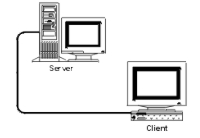In a client-server network architecture, however, certain computers are designated for full-time server duty, while others (such as user workstations) are full-time clients. For example, a file server will house hard drives containing files that all network users can access from their personal workstations. After working on a file, the user can then save the changes back to the server for safekeeping and collaboration. Another example would be a server set up as a dedicated 'post office' for an entire organization, collecting everyone's email from outside sources for internal distribution and serving as the transporter for all outgoing email. In this case each user's computer would be a client of the mail server. Both Peer-to-peer and Client-server network architectures have their advantages and disadvantages. On balance, however, a Client-server configuration is preferable to peer-to-peer, especially in a small business environment where there is an expectation of growth. The upside of the Peer-to-peer is that it is relatively inexpensive and fairly simple to set up and manage. The flip side is that it is limited in extensibility, tends to overburden user workstations by having them play the role of server to other users, is largely unsecured, and is typically unable to provide system-wide services since the typical workstation will run a standard desktop operating system incapable of hosting any major service (e.g., a post office). The upside of the Client-server is that it can extend to handle organizational growth, allows user workstations to function as unburdened clients, can provide sophisticated system-wide services, and is configurable for maximum security. The downside is obvious: higher initial capital investment to establish, and a greater level of technology expertise required to configure and manage, as compared to the vanilla peer-to-peer network. So, which to pick? On
to choosing an architecture ...
|
Client-Server Network: A network wherein certain computers act as dedicated providers of resources to some number of full-time client computers. File Server: A computer, typically higher-end than a workstation, which is dedicated to the task of providing file storage and file access for workstation users. Mail Server: A computer, typically higher-end than a workstation, which is dedicated to the task of collecting email for an organization from other mail servers on the Internet and distributing it to user mailboxes for viewing in an email client program. This server also serves as the transport agent for collecting organizational outgoing email and distributing across the internet. Extensibility: For example, the capability of a network architecture to expand to meet increased numbers of users and provide expanded levels of service as an organization increases in size and scope of work. Network Security: The ability of a network operating system to provide different schema, based on a maintained database of users and groups of users, where individual users and groups can be assigned varying levels of rights and permissions to access files and other resources. Typically minimal in a peer-to-peer architecture, yet more robust in a client-server configuration where a robust operating system, such as Windows NT Server, is deployed. |
